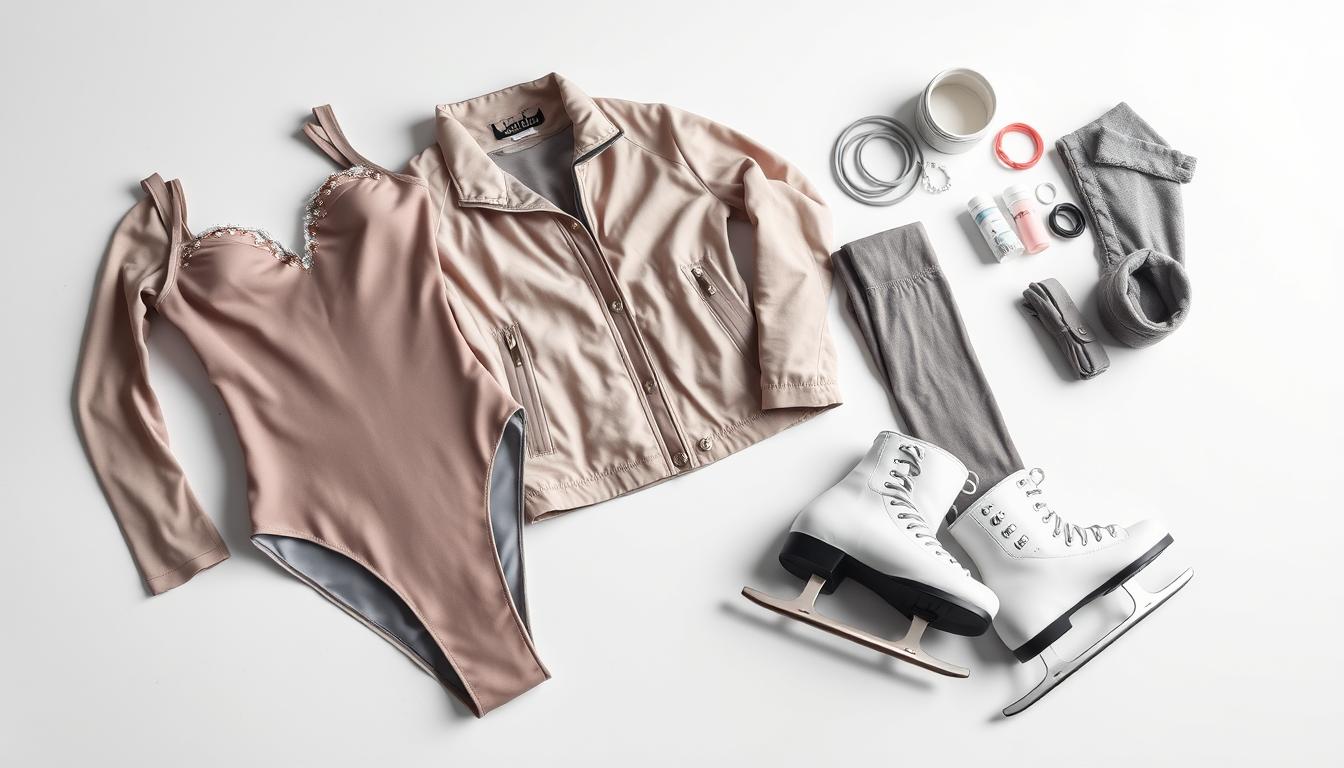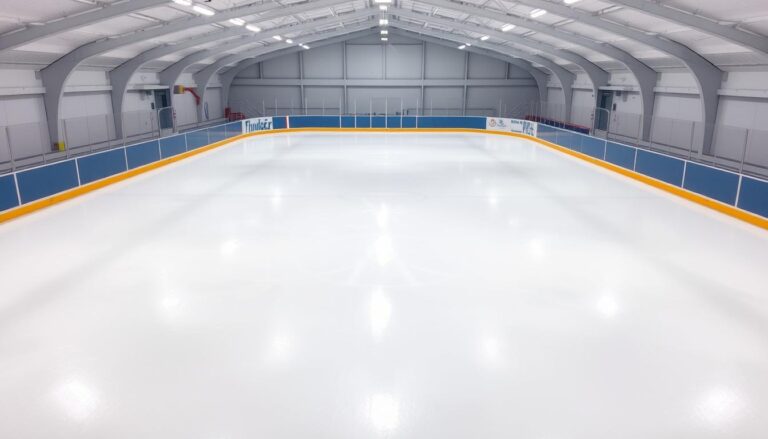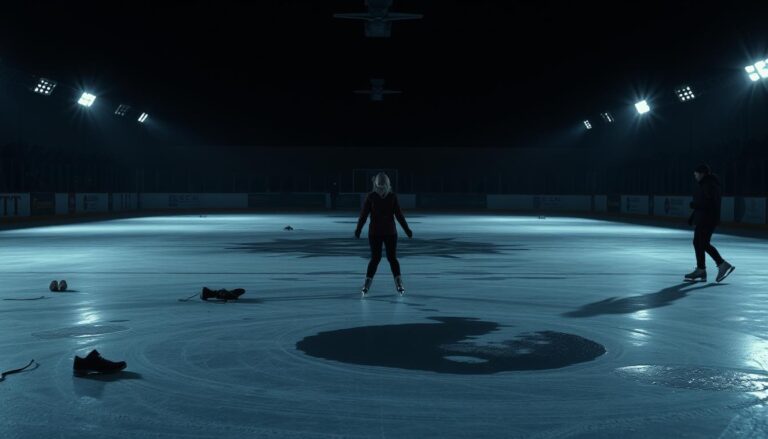Ice Skating Attire Guide: Dress for Success on the Ice
Stepping onto the ice is more than just courage and balance. It’s about wearing the right clothes. The right outfit can make your skating experience better, combining comfort, performance, and style.
Choosing the right ice skating clothes is not just about looking good. It’s about feeling confident and moving easily. The best outfit lets you glide on the ice with comfort and freedom.
When picking your skating clothes, think about the temperature, how much you’ll move, and safety. Both new and experienced skaters need clothes that support their movements and keep them warm.
Your clothes can affect how flexible you are and if you might get hurt. Layering your clothes is not just stylish. It’s a way to improve your skating, just like pros do.
Knowing about fabrics, fit, and how you move will make your skating better. Whether you skate for fun or to compete, the right clothes can boost your confidence and skills.
This guide will show you how to pick the perfect ice skating clothes. You’ll learn about base layers, outerwear, and more. Get ready to make your skating experience amazing.
Ready to find out how to dress like a pro for ice skating? Your journey to looking and feeling like a champion starts now.
Essential Ice Skating Clothing Basics
Getting ready for ice skating means knowing what to wear. The right clothes make your skating experience better. Look for clothes that perform well, feel good, and protect you.
Start with layering for your ice skating clothes. Skaters and coaches say it’s key to stay warm, dry, and move freely.
Base Layer Fundamentals
The base layer is the heart of your skating outfit. It does many things:
- Keeps your body temperature right
- Handles moisture well
- Starts to insulate you
- Prevents skin problems
Moisture-Wicking Properties
Choosing clothes that wick away moisture is key for comfort on the ice. Synthetic and merino wool are great for base layers.
| Fabric Type | Moisture-Wicking Rating | Comfort Level |
|---|---|---|
| Merino Wool | Excellent | High |
| Polyester Blend | Very Good | Medium-High |
| Nylon Synthetic | Good | Medium |
Temperature Regulation Features
New ice skating clothes have smart textile technologies. They adjust to your body’s temperature. Look for clothes that stay warm but don’t get too hot when you skate hard.
Your base layer should fit well but not limit your movement. Clothes that compress can help by supporting your muscles and improving blood flow while you skate.
How to Dress for Ice Skating: A Complete Guide
Dressing for ice skating is all about comfort, warmth, and being able to move freely. Knowing what to wear can turn a fun experience into a cold, uncomfortable one.
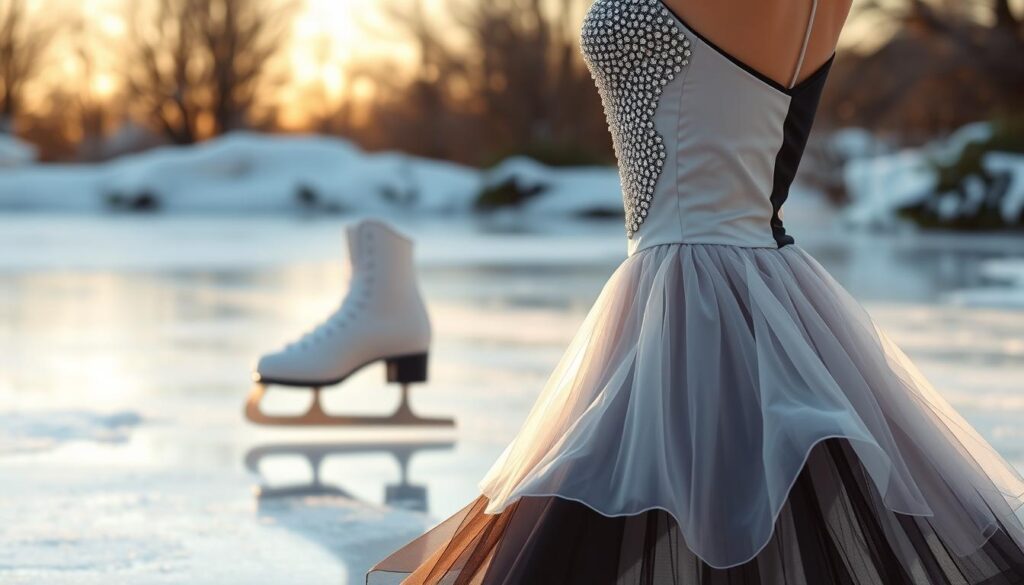
Here are the main things to keep in mind when dressing for ice skating:
- Prioritize flexibility and lightweight materials
- Layer strategically for temperature control
- Choose moisture-wicking fabrics
- Avoid bulky clothing that restricts movement
Your base layer is key for staying warm and comfortable. Thermal underwear or compression gear is great for keeping heat in while you move freely.
| Skating Environment | Recommended Clothing | Key Considerations |
|---|---|---|
| Indoor Rink | Lightweight pants, fitted top | Moderate layering, breathable fabrics |
| Outdoor Skating | Insulated jacket, thermal leggings | Wind-resistant outer layer |
Skating pros say to wear clothes that fit well and let you move easily. Baggy pants or sweats can mess up your skating and might even cause falls.
- Opt for stretchy pants or leggings
- Select long-sleeved, form-fitting tops
- Wear thin socks to improve skate control
Your outfit should help you reach your skating goals. Whether you’re just starting out or working on advanced moves, the right clothes matter.
Choosing the Perfect Ice Skates and Socks
Your skates and socks are key to a great ice skating experience. The right gear makes skating fun and comfortable. It’s all about finding the perfect fit.
When choosing the best clothes for ice skating, focus on your feet. Skates and socks are more than just accessories. They’re essential for your performance.
Proper Skate Fitting Tips
Finding the right skate fit is important. Here are some tips for comfort:
- Measure your feet at a skating shop
- Look for a snug fit with little heel movement
- Try skates with thin socks for a true fit
- Make sure there’s a thumb’s width of space at the toe
Sock Material Selection
Not all socks are good for skating. Avoid cotton. Look for socks that:
- Wick away moisture
- Keep your feet warm
- Offer compression support
- Have seamless construction to prevent blisters
Breaking in New Skates
New skates can be stiff. Here’s how to make them more comfortable:
- Wear them around the house with thick socks
- Use a skate stretcher for tight spots
- Apply leather conditioner to soften them
- Start with short skating sessions and increase time
Choosing the right skates and socks makes skating better. Remember, comfort builds confidence on the ice!
Protective Gear and Safety Equipment
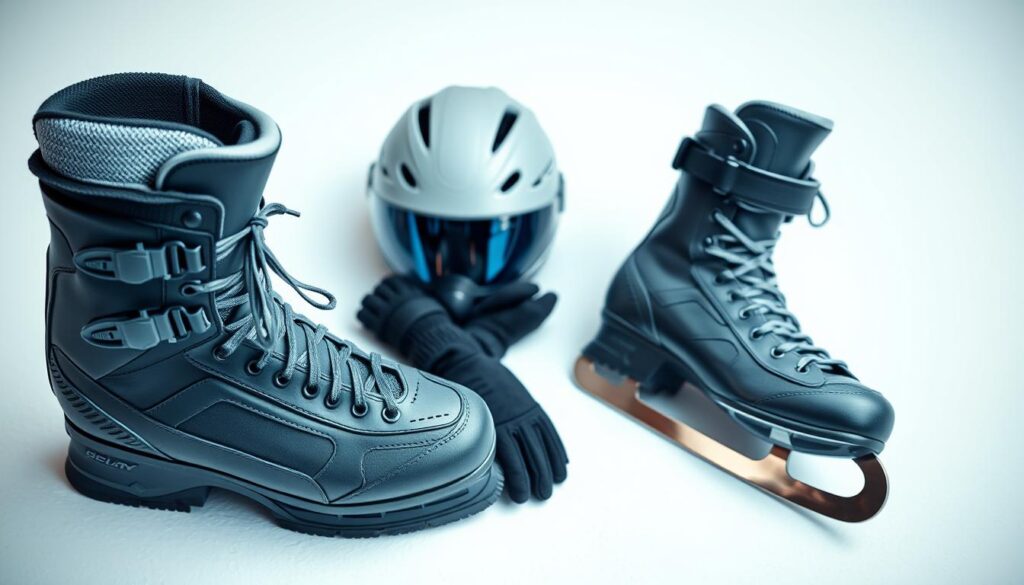
Ice skating is fun, but safety comes first. It’s not just about looking good; it’s about staying safe while you skate.
Protective gear is key for a safe skating experience. It helps prevent injuries and makes you feel more confident on the ice. Here are some must-haves:
- Helmet (critical for beginners and advanced skaters)
- Wrist guards to prevent fractures during falls
- Knee and elbow pads for additional protection
- Padded shorts for impact protection
Experts say good protective gear is important. It should let you move freely. Comfort and flexibility are just as important as protection.
| Protective Gear | Recommended For | Injury Prevention |
|---|---|---|
| Helmet | All Skill Levels | Head Trauma Protection |
| Wrist Guards | Beginners | Wrist Fracture Prevention |
| Knee Pads | Learning Skaters | Joint Impact Reduction |
Choosing the right gear lets you try new things without worry. The best skaters know how to fall safely and get back up.
Layering Techniques for Optimal Performance
Learning to layer is key for ice skating. It’s not just about looking good; it’s about feeling great and skating well. The right layers keep you warm and let you move freely.
The Three-Layer System Decoded
Layering for ice skating is all about strategy:
- Base Layer: Keeps your skin dry with moisture-wicking fabrics
- Middle Layer: Traps heat with insulating fabrics
- Outer Layer: Protects against wind and cold
Seasonal Layering Strategies
Seasons change your layering needs. Indoor rinks are different from outdoor ones. In winter, you need to keep warm. In summer, go for light and breathable.
Activity Level Considerations
How hard you skate affects your layers. Competitive skaters need special clothes. They want layers that manage sweat and are flexible.
- Beginner skaters: Focus on comfort and warmth
- Advanced skaters: Look for performance and less bulk
- Professional athletes: They need technical, precision layers
Remember, always carry an extra layer. Rink temperatures can surprise you. Having a backup keeps you ready for anything.
Best Fabrics for Ice Skating Comfort
Choosing the right fabric is key for a great ice skating experience. The right material can make your skating comfortable and enjoyable. Not all fabrics are good for ice skating.

Performance fabrics are essential for comfort and flexibility. Skaters need materials that:
- Excellent moisture-wicking properties
- Thermal regulation
- Maximum stretch and mobility
- Quick-drying capabilities
Now, let’s look at the top fabrics for ice skating clothes:
| Fabric Type | Performance Characteristics | Best Used For |
|---|---|---|
| Merino Wool | Natural temperature regulation, moisture-wicking | Base layers and warm-up clothing |
| Synthetic Polyester Blends | Lightweight, quick-drying, stretchy | Performance tops and leggings |
| Spandex Mixtures | Maximum flexibility, compression support | Competition costumes and practice wear |
Pro tip: Avoid cotton fabrics entirely. They absorb moisture and can leave you feeling cold and uncomfortable during intense skating sessions.
When building your ice skating wardrobe, choose technical fabrics. The right clothes can boost your performance. They give you the confidence and comfort to do complex skating moves.
Stylish Ice Skating Outfits for Every Level
Ice skating is more than just a sport—it’s a way to express yourself. Whether you’re new to the ice or a seasoned pro, your outfit matters. It affects both how comfortable you feel and how confident you look.
Finding the right ice skating outfit means knowing your skill level and skating style. Here are some ideas that mix function with fashion.
Beginner-Friendly Attire
For beginners, focus on comfort and being able to move easily. Look for:
- Stretchy leggings or fitted pants
- Layered tops that keep you dry
- Light jackets to stay warm
Competition Wear
Competitive skaters need outfits that show off their skills and creativity. Here’s what to look for in competition attire:
| Category | Recommended Styles | Key Considerations |
|---|---|---|
| Figure Skating | Rhinestone-embellished dresses | Light, flexible materials |
| Performance Skating | Sleek unitards | Designed for speed |
| Artistic Skating | Custom costumes | Reflects your artistic vision |
Practice Outfit Ideas
For practice, you want to be practical but stylish. Choose outfits that let you move freely and stay comfy. Here are some good options:
- Compression leggings with breathable tops
- Thermal base layers
- Light, fitted jackets
The best ice skating outfit boosts your confidence and lets you move freely. It should help you perform better, not hold you back.
Winter Weather Considerations for Outdoor Skating
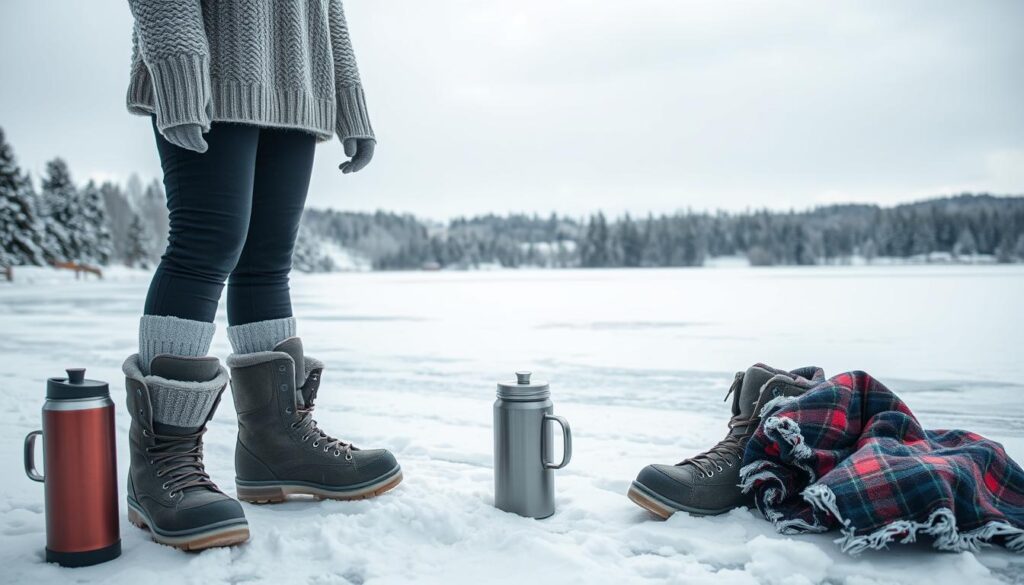
Outdoor ice skating turns winter into a fun playground. It’s important to know how to dress for cold weather. The right clothes can make skating a thrilling adventure.
Layering is key to staying warm. Begin with a moisture-wicking base layer to keep your skin dry and warm. Thermal underwear made from synthetic materials or merino wool works best. These fabrics keep you warm while letting your body breathe.
- Choose windproof outer layers
- Select insulating mid-layers
- Protect extremities with specialized gear
- Use thermal accessories
Make sure to protect your fingers, toes, and ears. Wear special gloves, thick socks, and a tight beanie. Skaters also recommend waterproof, breathable outer shells to keep you dry.
It’s important to manage your body temperature while skating. Choose clothes that let you adjust to changing temperatures. Zip-up jackets and removable layers are great for this.
Carrying hand and foot warmers can add extra comfort on very cold days. These small items can greatly improve your skating experience, keeping you warm and focused on the fun.
Professional Ice Skating Costume Guidelines
When you step onto the ice, your costume is key. It’s not just about your skills. Your outfit is a form of art that tells a story. It should match your skating style perfectly.
Competition Requirements
Choosing the right ice skating outfit is important. There are rules to follow:
- Costumes must be tasteful and suitable for competitions
- Outfits that are too revealing can cost you points
- Your body must be fully covered
Design Elements
Think about these design tips for your skating outfit:
- Pick colors that make your movements stand out
- Add sparkly details to catch the light
- Make sure your costume fits your performance’s theme
Fabric Selection
The fabric of your costume is critical. Choose materials that perform well for skaters. Look for:
- Fabrics that stretch and move with you
- Lightweight materials that don’t weigh you down
- Durable fabrics that last through intense skating
Pro tip: Lycra, spandex, and mesh are great choices. They look amazing and support your skating.
Accessories That Enhance Your Skating Experience
Improving your ice skating isn’t just about getting better at it. The right accessories can change how you feel and look on the ice. Ice skating fashion tips are about more than just looking good. They’re about being comfortable and functional too.
Choosing the right ice skating clothes is important. You need to think about both how they look and how they feel. Let’s look at the essential accessories that will make your skating better.
- Protective Gloves: Keep your hands warm and maintain grip
- Headbands: Control hair during complex moves
- Leg Warmers: Maintain muscle temperature between sessions
- Blade Guards: Protect your investment when off-ice
Choosing the right accessories can really help your skating. Here’s a detailed guide to the must-have skating accessories:
| Accessory | Purpose | Recommended Material |
|---|---|---|
| Gloves | Hand protection and warmth | Thermal-lined stretch fabric |
| Headband | Hair management | Moisture-wicking elastic |
| Leg Warmers | Muscle temperature regulation | Merino wool blend |
Pro Tip: Keep jewelry to a minimum on the ice. Avoid anything that could get caught or distract you.
Your skating accessories should match your outfit and improve your skating. Choose high-quality items that are both stylish and practical.
Common Clothing Mistakes to Avoid
Dressing for ice skating is more than just looking good. It’s about performing well, feeling comfortable, and staying safe. Many people make mistakes when choosing what to wear, which can affect their skating experience.
Choosing the right clothes for ice skating is not just about picking something cute. It’s about making smart choices to avoid problems on the ice.
Fit Issues That Can Compromise Your Skating
- Pants that are too long can cause dangerous tripping hazards
- Oversized tops create wind resistance and restrict movement
- Tight clothing can limit flexibility and range of motion
Material Choices to Avoid
Not all fabrics are good for ice skating. Some can really affect how well you perform and how comfortable you feel.
- Avoid cotton – it absorbs moisture and can make you cold
- Denim and heavy jeans restrict movement
- Non-stretchy materials limit your skating technique
Safety Concerns in Skating Attire
Some clothes can make skating unsafe. Loose accessories and the wrong shoes can be a big risk on the ice.
- Scarves can become entangled or catch on equipment
- Inadequate ankle support increases injury risk
- Slippery or inappropriate footwear can cause accidents
By avoiding these common mistakes, you’ll have a safer and more fun time skating. The right clothes can make a big difference between a smooth glide and a fall.
Maintaining and Caring for Your Skating Attire
Your ice skating clothes need special care to stay in great shape. The right care makes your gear last longer and perform better on the ice.
Looking after your ice skating clothes is more than just throwing them in the wash. Different materials and designs need their own care methods.
- Wash performance fabrics in cold water
- Use gentle, sport-specific detergents
- Air dry delicate items
- Store costumes and performance wear in garment bags
Keeping your skates in good shape is key for both performance and longevity. Regular cleaning and proper storage can prevent unnecessary wear and tear.
| Fabric Type | Washing Recommendation | Drying Method |
|---|---|---|
| Spandex Blend | Cold water, mild detergent | Air dry, flat |
| Rhinestone Costumes | Hand wash, inside out | Hang dry, avoid direct heat |
| Thermal Base Layers | Gentle cycle, cold water | Tumble dry low |
Special care for your skating clothes stops colors from fading, keeps fabrics stretchy, and keeps your outfit looking sharp. Spend time on proper care to protect your ice skating wardrobe essentials.
- Inspect costumes for loose sequins or threads
- Store skates in a cool, dry place
- Use protective blade guards
- Clean blades after each use
By following these care tips, your skating gear will stay in perfect condition. It will be ready for your next show or practice.
Budget-Friendly Skating Wardrobe Tips
Creating a stunning ice skating wardrobe doesn’t have to cost a lot. Smart skaters find ways to save money while looking great on the ice. With a few clever tips, you can build a stylish collection without spending too much.
Begin by choosing versatile pieces that can be mixed and matched. Look for neutral-colored base layers that can be updated with affordable accessories. Layering is key to creating multiple ice skating outfit ideas without purchasing an entire new wardrobe.
- Shop end-of-season sales for discounted skating apparel
- Check second-hand sporting goods stores for gently used items
- Invest in quality basics that can be styled multiple ways
- Learn simple DIY costume embellishment techniques
Thrift stores and online marketplaces are great for finding deals. Many professional skaters suggest looking on eBay or specialized skating resale groups for quality gear at lower prices.
Accessories are your secret weapon for changing up basic outfits. A few sparkly hair clips, strategically placed rhinestones, or colorful leg warmers can completely transform your look without spending a lot.
- Rhinestone patches ($5-$10)
- Colorful hair accessories ($3-$7)
- Mix-and-match leggings ($15-$25)
- Affordable performance layers ($20-$40)
Pro tip: Always choose comfort and function over looks. A well-fitted, practical outfit that allows for movement will always look better than an expensive costume that hinders your skating.
Conclusion
Learning how to dress for ice skating changes your whole experience. The right clothes mix function with style, making you feel good and ready to skate. Each piece, from base layers to outerwear, is key to your success and fun.
Wearing stylish ice skating clothes is more than just looking cool—it’s about feeling strong. Every skater finds clothes that show who they are and help them skate better. Whether you’re new or advanced, your clothes can really make a difference.
Your skating clothes collection grows as you get better. Learn about fabrics, layering, and what feels right for you. Try out different looks, listen to your body, and change your clothes as you improve.
Ready to make your ice skating better? Use what you’ve learned from this guide. Choose clothes that make you feel good, keep you safe, and show your style. The ice is your stage—dress to impress and let your love for skating show in every move.
